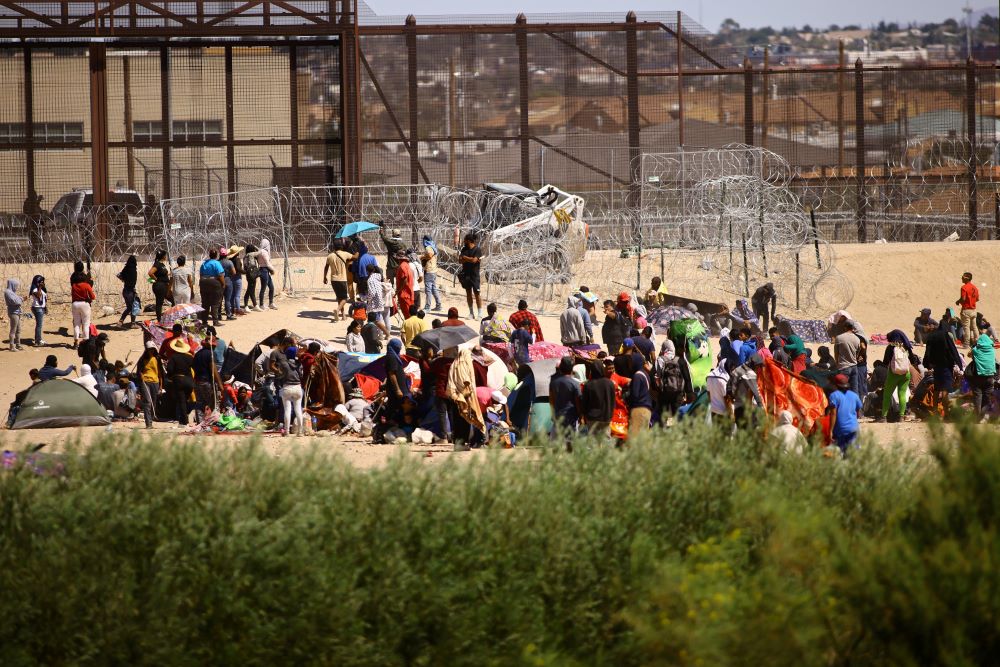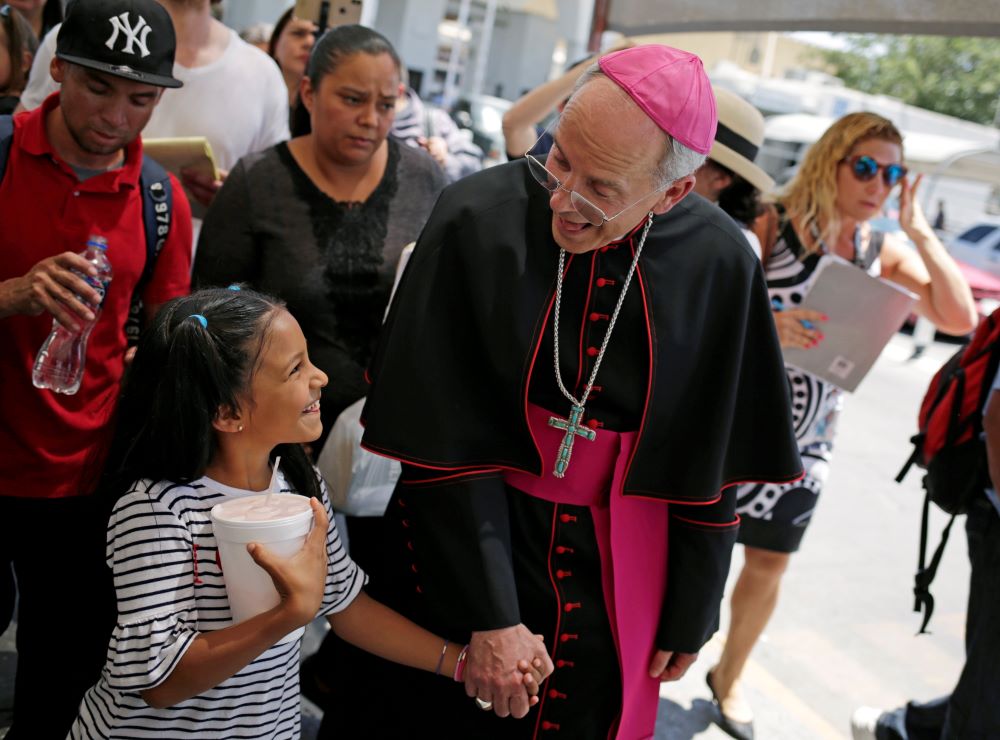Migrants are battered by dust kicked up by high winds as they wait to be picked up by U.S. Customs and Border Protection officers near the U.S. border wall near El Paso, Texas, May 10. The next day, Title 42, which had blocked migrants at the U.S.-Mexico border from seeking asylum since 2020, expired. (OSV News/Reuters)
This summer, in the aftermath of the rollback of Title 42, the Hope Border Institute and the Diocese of El Paso operated an emergency shelter to provide a dignified welcome to our migrant brothers and sisters.
One of our many guests was Noemi, a mom of three from Colombia who didn't know anyone in the U.S. Waiting for two of her three children still in detention, she would often ask: "Where am I going to go? I don't know anyone in this country."
Thanks to the support of a willing bishop, Archbishop Thomas Zinkula, the can-do attitude of a Catholic Worker organization in Iowa and a welcoming parish community, Noemi was able to get to her destination and find a community where her family now feels they belong.
The U.S. Catholic Church faces a decisive moment in fulfilling its preferential option for this new population of vulnerable people on the move.
Noemi and her family are like many newcomers arriving at the border with little to no ties in the U.S., yet eager to contribute to this country. The U.S. Catholic Church faces a decisive moment in fulfilling its preferential option for this new population of vulnerable people on the move.
For the first time, asylum seekers and vulnerable migrants from countries other than Mexico and Northern Central America now represent the majority of people seeking protection at the border. In September, Venezuelans were the largest national group arriving at the border, continuing a trend that began when the current political, economic and social crisis in that country started nearly a decade ago.
Many drivers contribute to this new migration trend from South America, including the ongoing situation in Venezuela, increasing insecurity in Ecuador, lack of opportunities in Peru and Colombia, racism against Black and Indigenous populations throughout the continent, as well as a U.S. labor market thirsty for workers.
Compared with migration from Central America and Mexico, those coming from South America have significantly fewer connections and communities of support in the United States. In addition, those arriving at the U.S.-Mexico border face significant barriers to legal employment and federal benefits. And even within the ecosystem of Catholic and faith-based agencies and initiatives, there are fewer resources to offer continuity of care, including pastoral care.

Migrants, mostly from Venezuela, are seen from Ciudad Juarez, Mexico, as they gather near the U.S. border wall Sept. 24 after crossing the Rio Grande with the intention of requesting asylum. In September, Venezuelans were the largest national group arriving at the U.S. border. (OSV News/Reuters/Jose Luis Gonzalez)
The Catholic Church in the United States has a long history of working to welcome and integrate newcomers through its broad network of parishes, social service agencies and educational institutions. But these new patterns and needs are forcing us to rethink the model of migrant reception and promotion.
Instead of a problem to be solved, this can be a renewing moment for the Catholic Church in the U.S., as we described in our recent white paper, in the work of (to use the words of Pope Francis) effectively welcoming, protecting, promoting and integrating our new neighbors.
How can the church meet the moment?
First, the Catholic Church has the expertise, muscle memory and infrastructure to welcome new migrants. Relying on the experience of refugee resettlement, the church can work to scale up existing pilot initiatives to accompany asylum seekers from the border to interior cities, such as the Jesuit-led Migrant Accompaniment Network and "The Border Is Everywhere," a pilot project launched by the USCCB and national Catholic agencies.
Second, the Catholic Church has the creativity and people power needed to expand welcoming efforts and improve coordination. When considering how to receive asylum seekers at the border and in the interior, discussion often focuses on the challenges of funding and personnel. But many Catholic efforts
already demonstrate that these challenges can be overcome, especially by engaging ordinary Catholics in the pew in creative ways.

Bishop Mark Seitz of El Paso, Texas, shares a smile with a Honduran girl named Cesia as he walks and prays with migrants at the Lerdo International Bridge in El Paso June 27, 2019. (OSV News/Reuters/Jose Luis Gonzalez)
In El Paso, we have witnessed how a small and under-resourced community has been able, through effective community organizing, to humanely welcome thousands of people. In Chicago, the church is actively organizing local parishioners (many of them migrants themselves) to meet the needs of those arriving in the city through its effective Pastoral Migratoria program. In Boston, Cardinal Sean O'Malley has called on parishes to mobilize and contribute to the efforts of the broader community to welcome those coming from the border.
Third, existing pilot humanitarian relief apps, such as the relief organization CORE's CoreConnect, show that it's also possible to facilitate a secure platform in order to facilitate a smoother connection between needs at the border and resources in interior cities. These apps can identify gaps in services and address them.
Advertisement
Finally, it is important to work together and in concert with other similar initiatives on critically needed policy changes. This joint advocacy can amplify the voices of migrants the church accompanies and lift up the full potential of the church's moral leadership in migrant empowerment and protection. The recent experience in cities like Chicago and New York demonstrates the clear need for Congress to pass legislation to allow asylum seekers to quickly apply for work permits so that they can provide for their families without needing to rely indefinitely on government assistance.
As winter approaches and needs for immigrant shelter at the border and in the interior increase, the church has an opportunity to bring this work to the next level by studying lessons learned, embracing enhanced coordination and developing new partnerships. A national dialogue is needed among our Catholic social service providers, other organizations working in this area, pastors and parishioners, as well as migrants themselves, to develop programming responsive to the needs of this latest generation of new Americans.
As it has done for generations, the Catholic Church in the U.S. has an opportunity to renew our agencies and parishes by meeting the current moment and effectively accompanying asylum seekers and vulnerable migrants at the border. With faith, compassion and a touch of creative organizing, we can transformatively walk with thousands like Noemi in finding safety, better opportunities and healing and, in the journey, be converted ourselves.




